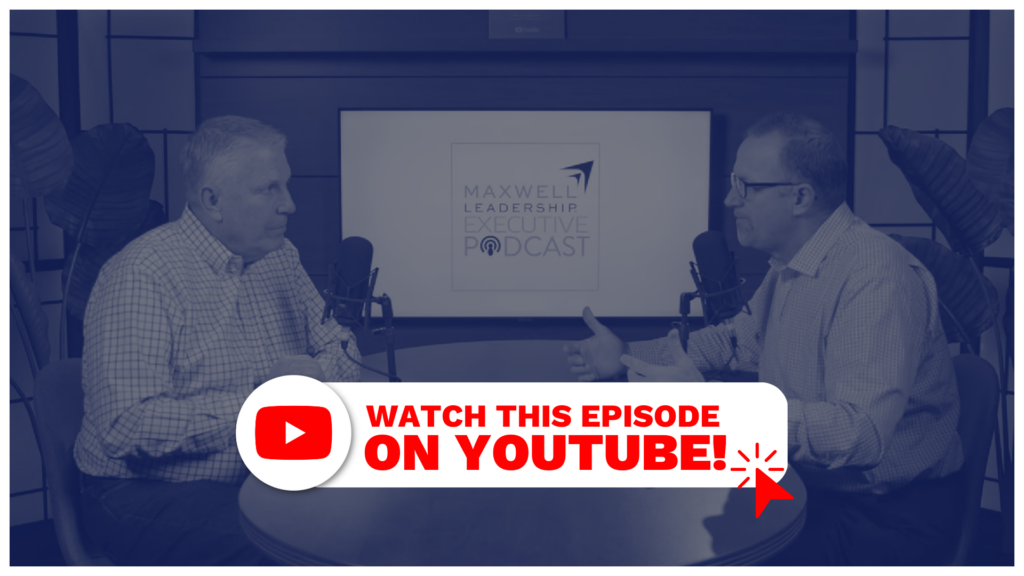Executive Podcast #279: Why Do the Majority (70%) of Change Efforts Fail?

The staggering failure rate of change efforts stands at a significant 70%. Such a high failure rate sheds light on the pivotal role of people-related challenges that often lie at the heart of these failures, specifically, the resistance to change. We explore essential elements for driving successful change efforts, emphasizing the significance of executive support and active sponsorship. We also look at the importance of adding value and maintaining attentiveness to the team’s needs throughout the change process, recognizing the profound impact of engaging and supporting team members during times of transition.
References:
Become a Maxwell Leadership Certified Team Member!
Register for Day to Grow on March 9th, 2024!
Download our Learning Guide for this podcast!
Perry Holley:
Welcome to the Maxwell Leadership executive podcast, where our goal is to help you increase your reputation as a leader, increase your ability to influence others, and increase your ability to fully engage your team to deliver remarkable results. Hi, I’m Perry Holly, a Maxwell leadership facilitator and coach.
Chris Goede:
And I’m Chris Goede, executive vice president, Maxwell leadership. Welcome and thank you for joining. I want to take just a minute, and I want to encourage you to use these podcasts as a resource to help develop your team. We talk a lot about the fact that, man, it’s important as a leader to invest in and develop your people. A lot of leaders go, I don’t have time for that. What does that look like? I don’t even know how to do that. One of the great ways that we hear feedback from teams all the time is that a leader will send these lessons and then they’ll ask for, hey, what was your 1 minute takeaway before they start a meeting? And they go around and it leads to great conversations. And so it’s just a magnificent way for you to be able to interact and to develop your team by using some of this content.
Chris Goede:
So I want to encourage you to do that. I also want to encourage you to go to maxwellleadership.com/podcast. And there, if you’ll click on this episode, you can fill out the form with a question you might have or if you’re interested in having an executive coach or facilitating some of our content, Perry Holly is available and looking for work. We would love to partner with you and help you with that and really learn more about what you’re struggling with and how we can help develop the culture inside your organization. You can fill out the form and do that there. Well, I love where we’re going with today’s title because we’re on this theme right now around say it in last week’s. It is easier to say than last week’s. That’s right, long time listeners.
Chris Goede:
Perry always challenges me with the words of a title. I think he sits back and laughs and says, I can’t wait to hear Chris say this back and laugh.
Perry Holley:
I lean forward and laugh.
Chris Goede:
That’s right. He’s into it. But we’ve been talking a lot about how to handle change, and not in a positive way, but how to work through it and like, change is going to happen and you just need to do this and change is all going to work. Change doesn’t always work. And we’re going to dig into a little bit about that today because according to Mackenzie consulting, 70% of change efforts fail, and then 70% of the time it’s because of the people problems that are involved with the change that we need to address. And so this is a leadership problem for sure. And so today’s topic is why do the majority of change efforts fail? Perry Holley, take us away.
Perry Holley:
Yes. Well, I’ve been looking into this and investigating what are some of the major people problems? If that’s true, what are the things you can expect to deal with? And number one problem that shows up in every change effort that I’ve seen is resistance to change. That’s a people problem. People are resistant to change, and it could be due for any number of reasons, the discomfort with the unknown or misunderstanding or even disagreement with the direction or the goals of the change, where we’re going, fear regarding their own job or job security. It could be affecting me personally. Lack of trust in the management team has come up a lot in some of the surveys that I’m not sure they know what they’re doing or I don’t want to bet my career on what they say. I’m guessing if you’re a leader, you probably have seen or experienced some of all of these when it comes to leading a change effort. My personal point of view is, and I got this years ago from a coaching certification I got, was that, and I’ve heard my whole life, that people hate change.
Perry Holley:
And what I realized when I got this coaching certification was that change is all of life. If you didn’t change, you never would have done anything. You never would have driven a car, gone on a date, gotten married, had children, gone and changed job.
Chris Goede:
You wouldn’t do anything.
Perry Holley:
Change is a part of everyday life, and we do embrace it. But what we do hate is we hate the feeling of losing control that is caused by change. Anytime change happens, I feel like I’m losing some control. And you’ll start to notice that people will go out of their way to do things just to maintain control. What are your thoughts when I say that you’re shaking your head. Is that resonated?
Chris Goede:
Yeah, it’s the unknown for me. Right. The way that I’m wired, I tend to analyze things a little bit too much and got to know the data behind it and this and that and that. And when also, when change comes and I don’t have that knowledge. Right. I feel like I have a little bit of loss of control. I don’t know. And so you get a little bit of that anxiety around change that I think a lot of leaders feel a lot of our team feels.
Chris Goede:
And so one of the things that I think we can do to reduce that feeling of losing control is obviously communicate the why behind the change and why it’s important for their role and what they’re doing inside the organization around the change, and then just be honest with them. How is it going to affect them. Be very transparent when it comes to that, then set the tone of what can they expect when the change comes to fruition. What’s the new world look like for them and how that’s going to be good for them. All of that is going to help. It’s not going to completely take it away, but it’s going to give them some information. The other thing, too, I was thinking about as you were just talking was people receive communication two different ways. They either receive the how really well, how are we going to go about this change, or they receive the why.
Chris Goede:
We’re going to go about this change. We need to be aware of that. Because your team is built into the different how and the why. And so you may have to communicate to both during the same message, or you may have to have one on ones and really get into the how with some to help them feel like they’re not losing control or others. You just got to really get behind the why and they’re like, hey, let’s go anyways. And so I think you got to know your people, you got to understand your people. And if it’s truly back to what the stats were talking about of being people problems, then as a leader, we got to make sure that we’re digging into that and understanding how our people are going to receive it.
Perry Holley:
Yeah, I’m always shocked when leaders announce a change effort and they fail to realize they don’t put it in their first paragraph. Everybody’s tuned into the same radio station, which is WiFM. It’s an old saying, but it stands for what’s in it for me. And everybody’s listening to you while you’re talking and they’re asking themselves, how is this going to affect me? And so I think one of the first things you can do to reduce, I agree with you, you’re probably not going to completely eliminate resistance. People do things for their reasons, not for yours. However, I think you can reduce it quite a bit by answering that what’s in it for me? Question right from the top.
Chris Goede:
Yeah.
John Maxwell:
Hey, John Maxwell here. I’m in the studio. We’ve been recording all day, and I was thinking about really one of my very favorite experiences that we have, and that is called day to grow. If you want to grow, you want to grow in every area of your life. I tell people all the time, you don’t want to go to something. You want to grow to something. But if you’re passionate about personal growth, development, your team and growing them, you do not want to miss day to grow. I’m going to have some real players with me, Dion Sanders, Jamie Kern, Lima, myself.
John Maxwell:
You don’t want to miss it. So market, come and see us on day to grow. I will promise you this. You come and bring your team. At the end of the day, you’ll come up and shake my hand and say, one of the best days I’ve ever invested in for myself and for my team. I’ll see you there.
Chris Goede:
One of the things that we need to make sure that we’re doing as leaders and we want to encourage you to do this is make sure everyone’s informed. I’ve talked about this on a previous podcast. This is one thing that where I need to really check myself at times and slow down and say who all should be involved in this communication of this change and really maybe over communicate that. Maybe over invite that on the invite list. Some people may read through and be like, why are you including me? And I’d much rather that happen than somebody come to you and say, hey, how come you didn’t include me on that? Because it directly impacts me and my change. And so the question here is then how and what do we over communicate when we’re going through change? We talked a little bit about the why, how it’s going to affect them. But I also think you need to be as specific as you can at the time, as much information as you have, and you can share about the timing of it, the deliverable, what’s the plan behind it, so that they know that you put some thought into that, and then what is the new plan going to look like versus the old one and why is it not working? Give them some of that conceptual context behind the change. I think that’ll help.
Perry Holley:
I was looking forward to sharing this one because I want to hear what you think because you as an executive and you are leading a lot of the change we’re doing. It says that I think another part of the people problem that happens is caused by a lack of executive support or active executive sponsorship. They come in, I’ve been this many times, I was with a very large company for a lot of years. They come in and say, here’s what we’re doing. And then they disappear. And I just thought that without seeing and feeling the support of leadership in this, it can really cause change efforts to falter, to fail. This one really resonated with me. But what’s your thought about executive role? You’ve announced the change.
Chris Goede:
Should you, I’ve seen run, yeah. And it’s interesting you say, I hadn’t thought about this, but I’ve seen even change that we’ve tried to do here at other organizations to where it is that where they go, hey, here’s the change. And then the leadership team doesn’t support that. We talk a lot about the common language, inside cultures, and it made me think about this to where, as you have people reflect on your own leadership, you come into a room sometimes and you say, hey, what’s it look like to be on the other side of my leadership? And then you run out of the room because you really don’t want to know the answer. I think that happens with leadership where they think it’s a good idea for the change. They understand from a bigger picture why, but maybe they’re not supporting at that table, but they want you to try to do it. And then when it fails, they come back and they say, hey, this is on you. We asked you to make this change, but it was never supported from the get go.
Chris Goede:
And I think that’s crucial. I think it’s huge that the leadership team inside any organization is behind and supporting not only in their language, but also in their belief and their actions and their resources, that that team is behind what that change is and that they’re talking about that change and they’re getting updates on that change and they are making sure that it is very apparent to the team that’s running the change that they support that. Because if you don’t have that, it’s just like we talk about with leadership and the culture and the change. It’s like going into one of our sessions, consulting sessions, a training session with organization, and we’re working with a team and the CEO comes in and kicks it off and then they walk out of the room.
Perry Holley:
Yeah, gone.
Chris Goede:
What is the message does that give it? Oh, well, they’re checking out, right? They’re not going to dig in and they’re going to have robust conversation and they’re not going to definitely do something when they leave here because our CEO or the leader that invested in this for us just walked out of the room. It’s the same thing with change.
Perry Holley:
I absolutely love it when they kick off a session, turn it over to me and the CEO sits down. He or she sits down right at one of the front tables and starts to contribute and ask questions. Sends a message, really great message to others. Another people problem is often caused maybe a little bit similar to executive sponsorship, but it really is. I just called it weak leadership or weak vision that maybe they’re not really bought into. What is the reason for the change? So the leadership doesn’t communicate well, as you were just saying, they don’t really have a clear, why are we doing this? Why is this important? It’s not connected to our vision for the company. It’s just a rogue change we’re going to do. And they don’t put the leadership into it.
Perry Holley:
And we’ll go back to your point just now. They tend to under communicate it, undersell it, under empathize. They don’t do any of the things they should be doing with the team because they’re not really completely bought into it. And so they communicate it poorly and.
Chris Goede:
It comes across as an absentee leader to where you just feel like you’re just to your point, dictating what you heard and this is what we need to do and you’re not in alignment with what really is happening. I would encourage you to make sure you may not always be in agreement with the change.
Perry Holley:
Ask you that though, right? How would you coach that, though? If you had a leader who’s got a change coming? Mean, this could be you. So Mark’s calling, got a change coming down and you may not. It really wouldn’t happen here because you guys are so tight and you communicate so well. But I’ve seen it in other places where it’s coming down and they don’t really buy into it. How would you coach a leader?
Chris Goede:
You’ve got to get understanding. You have to be in alignment. You may not be in complete agreement. I have to sometimes have this segment help me understand, help me get the picture of why this small puzzle is going to fit into the bigger puzzle. Get me there. You’ve got to get me there first because I then have to lead my team through that. Right. And so for me, it’s like I may not be in complete agreement, but I’m going to ask a lot of questions and I’m going to need a lot of conversation to make sure because here’s why.
Chris Goede:
As leaders, we want to make sure that when we’re talking to our team, when we’re working with our team, when we’re rolling up our sleeves and we’re in the field with our team, that we are in alignment with this change. Otherwise it’s going to be all over our face and they’re going to see it. Everything we’ve talked about in previous podcasts on change, on stuff like I’ve got to get there myself at that leadership level before I can even go to my team with it. Otherwise, I have a hard time doing it or maybe won’t do it, and maybe I step away from that change and have somebody else that does, because it’s not for the betterment for the organization, for me to lead that maybe somebody else needs to lead that.
Perry Holley:
I reported to a CEO once, and he had this great knack for communicating vision, but he also realized we should have a point of view on that. So we would be in the closed room and he would encourage debate, dissent, argument, pushback, whatever you wanted, you could unload on what the initiatives were, where we’re going. But his rule was that after the debate, we’re going to decide, and he may decide, he may make the decision, and we may not all be in agreement, and you used the exact right word, is that we will be in alignment. Nobody goes out of the room and says, well, they decided, no, you decided. You may not be in agreement, but you are in alignment with the team. And your team then knows that if you show any kind of misalignment, 100%, it is totally going to undermine everything you do. On that. Another idea was, I think, people problems that are caused by insufficient support and buy in from the team.
Perry Holley:
People aren’t bought in and they don’t feel like they’re being supported or they’re being. The resources necessary are committed. You’re asking me to do a big thing and then I don’t really get the support and buy in that I need. It’s going to derail every change. Initiative you have is going to fail if people aren’t bought into that.
Chris Goede:
Yeah. And going back to John’s 21 irrefutable laws of leadership and the law of buy in, this goes back to what we were just talking about in regards to what if you’re not in alignment, your team, they’re going to buy into you as the leader before they’re going to buy into the change and the vision.
Perry Holley:
That’s why influence is so important.
Chris Goede:
It’s so important. Right. It goes back to the five levels of leadership and understanding how to increase your levels of influence. Even without titles. We’re not talking about titles. You may ask to lead a change. That may be something very simple, but you’ve got to have influence to be able to do that, but they’re going to buy into you before they’re going to buy into the change or the vision. And so we need to make sure that we’re focused on that when it comes to supporting your team in this and this buy in.
Chris Goede:
One of the things I want to make sure that we just mentioned here, I think it’s really important, which is we’ve got to make sure that we’re very attentive to our team during change. How and where can we add value to them through this process? Change is not easy. Sometimes it’s going to hurt more than others and sometimes it’s positive. But we’ve got to always be thinking about how are we going to add value to the people, to the team? How can we, with the resources that we have, add value to the team that’s leading that change for us?
Perry Holley:
Yeah, I think something you said earlier about that I rarely see leaders do is really a good insight. You shared about asking for feedback along the way. How are we doing? How’s it working for you?
Chris Goede:
What do you think?
Perry Holley:
What do you think? How’s it feel? Where are we coming up short? Why is this wrong? Why is this right? I mean, getting people talking about it, letting them know that first of all, they see you, you’re present and you care. It just, even though it’s going to be hard, I’m not saying it’s going to get any easier, but I am here with you to do that. It starts to resolve a lot of these people issues.
Chris Goede:
Yeah. Right before the scheduled meeting that I had in a kind of a year in wrap up, I was talking to a person that’s affected by change inside our organization and I did that. I said, hey, give me some feedback and leaders just, you need to do that and then you need to be ready to listen and you need to act on that. And I had some time to really think about the feedback and most of it was right and was spot on. But I needed to hear it as a leader because I need to know where my people are. I need to know where we missed it. I need to know where we are exceeding in that. And so we need to be able to do that.
Chris Goede:
And so be able to do that well. As I wrap up this incredible lesson on change, that it doesn’t always go well, it’s going to fail. I want to encourage you to control what you can control as a leader, and oftentimes that is by supporting and driving and engaging culture with your team through the process we are in, the people business. We say this all the time. We work with all kinds of different industries, manufacturing, automotive industry, all kinds of across the board. But at the end of the day, we’re all in the people business. And so you need to make sure that you can control what you can control. Change is going to fail.
Chris Goede:
Many, many different reasons why, right? And so it’s okay if it does, but when it does succeed and it goes well and you were supportive and you engaged your team, the wins along the way will be celebrated at a much higher level through that process. And so I just want to encourage you. You can’t always control all the factors of a change, but there are things that you can control, and a lot of that has to do with how you’re leading your people.
Perry Holley:
Fantastic. Well, great conversation once again. And just a reminder, if you’d like to have the learner guide, you can do that at maxwellleadership.com/Podcast. You can also learn about our other family of podcast offerings we have, as well as the five levels of leadership. You can also leave us a question or a comment at that location. We’re grateful for you joining us. Always love hearing from you.
Perry Holley:
And that’s all today for the Maxwell Leadership executive podcast.
To be a Successful Leader, You Need Feedback on Your Leadership.
We’re excited to announce our new and improved Organizational Effectiveness Survey (OES). The OES gathers feedback from employees to give leaders and management the knowledge and action plans needed to develop a more effective and productive work environment. Our new version measures 4 areas of your business: Leadership, People, Strategy, and Performance.













Be the first to comment on "Executive Podcast #279: Why Do the Majority (70%) of Change Efforts Fail?"